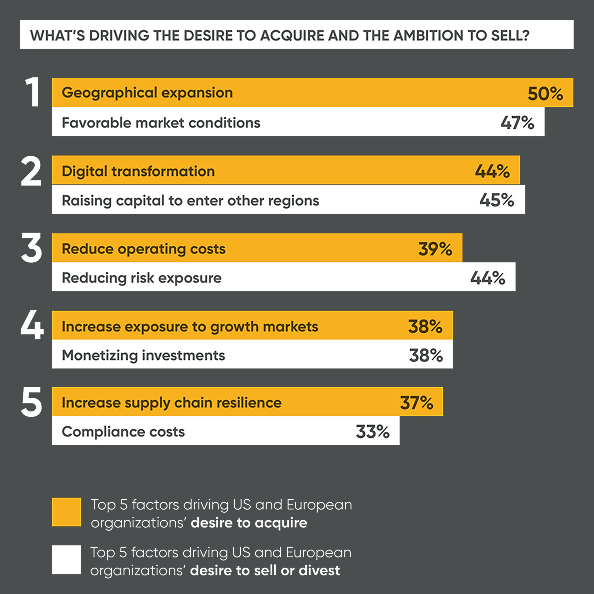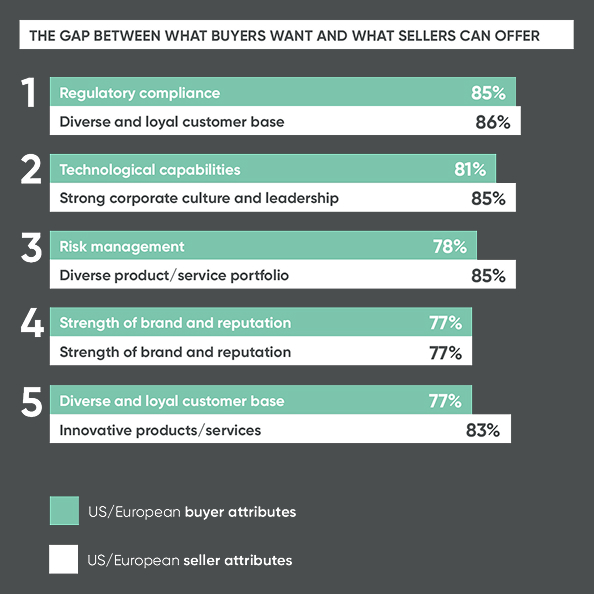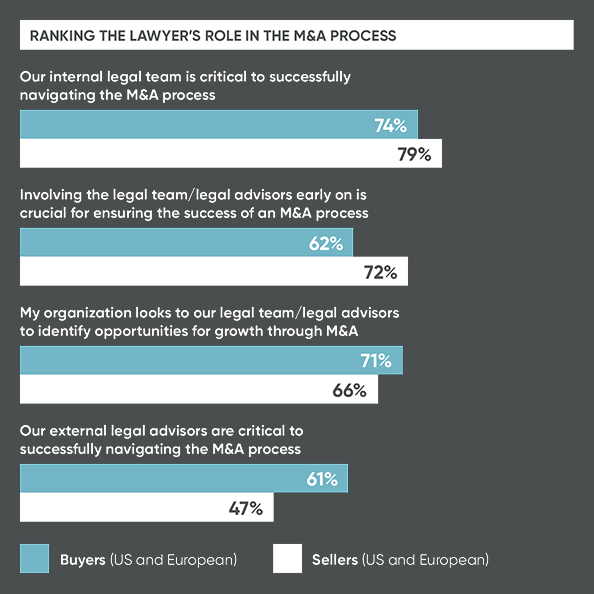Is corporate deal-making on the brink of a long-awaited surge?
This report examines the appetite for M&A from both a buy-side and sell-side perspective. It explores key M&A drivers and barriers and looks at ways that business leaders can bridge the gap between intention and action.
This advice is especially timely as companies around the world—including our clients—pursue investment opportunities to recalibrate their strategies in response to the newly announced U.S. tariff policies, while also addressing the pressing need to reduce reliance on global supply chains.
Based on independent research of US and European business leaders looking to undertake acquisitions or disposals, our report reveals 73% of business leaders believe that a proactive M&A strategy – carefully planning and executing deals to achieve long-term business goals, rather than reacting to market conditions – is critical for organizations to prepare for an era of disruptive change.
While there are a number of factors providing headwinds for M&A activity, including market volatility and a challenging economic environment, many of these forces are also slowing the pace of transactions. Despite companies’ enthusiasm to use M&A to bolster their capabilities, several blockers stand in the way, including a buyer-seller mismatch and market complexity driven by intensifying regulation: 74% of leaders say that increasing regulation is making M&A activity much more challenging.
In a period of high pressure on profit margins and rapid technological and geopolitical change, leaders are looking at transactions to accelerate growth and transform their organizations. Pent-up demand is building, ready to be unleashed once the market dynamics shift.
Getting Deals Done explores ways that business leaders can unlock these opportunities and those M&A ambitions. While the deal-making landscape has become more complex, it also holds huge potential.
This report aims to provide valuable insights and practical strategies to help leaders navigate complexities, maximize value, and achieve successful deal-making outcomes.
Carol Osborne, Partner and Global Department Leader - Corporate and Finance Transactions

The desire to acquire
What are the main factors motivating business leaders to look for M&A opportunities?

Dealing with complexities
How are complexity and regulation hindering M&A strategies?

Sealing the deal
How can leaders navigate the increasing complexity of the M&A landscape?
Dealmaking in a dynamic M&A market
In this podcast episode, we explore the evolving world of M&A in 2025 – a year already marked by geopolitical uncertainty, regulatory complexity, and shifting investor sentiment. We hear from BCLP’s Jinal Shah and Todd Kaye who bring their global perspectives to the table and offer a candid look at the forces shaping global M&A activity across markets and sectors.
Executive summary
Getting Deals Done maps the M&A motivations of both prospective buyers and sellers, examines the complexities that are holding deals back, and considers how business leaders can get their organizations "deal-ready" to unlock the potential of M&A transactions.
The desire to acquire
In a turbulent context, characterized by volatile intersest rates, rising populism, and isolationist economic policies, business leaders are actively seeking opportunities for M&A to enable their organizations to thrive.
Dealing with complexities
Many of the forces that are making M&A so critical - including market conditions and financial and compliance challences - are also complicating deal-making: 58% of leaders say that income anxiety is slowing down their organization's M&A strategy.
The top five factors contributing to increased complexity in the M&A landscape (US and European buyers and sellers):
Sealing the deal
To close the gap between M&A ambition and actions, leaders need to prepare for transactions, either buy-side or sell-side, making their organizations "deal-ready" so that they can pivot quickly.
To negotiate this complexity and unlock the opportunities that M&A can bring, leaders can look to their internal and external legal teams, investment firms and M&A advisors to help them find opportunities and secure deals.
In the chart on the right, buyers and sellers identify the importance of various lawyer roles in the M&A process.
The report
Getting Deals Done maps the M&A motivations of both prospective buyers and sellers, examines the complexities that are holding deals back, and considers how business leaders can get their organizations “deal-ready” to unlock the potential of M&A transactions.







